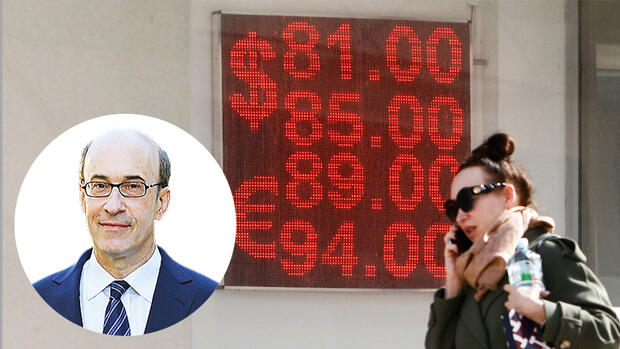US President Joe Biden has described the current sanctions against Russia as “the most comprehensive sanctions regime ever imposed on a country in history”. That was true, but at the same time misleading.
Sanctions imposed by the US elsewhere – such as North Korea and Iran – were much more severe than the current sanctions on Russia because they included secondary sanctions against third countries that continued to trade with those regimes. In the case of Russia, this is just beginning.
Russia continues to sell oil to India and China and buys fresh fruit and vegetables from Israeli exporters. In addition, there is trade on an enormous scale by means of so-called reloading. It is true that European exports to Russia have fallen due to sanctions; at the same time, however, the volume of trade between Russia and countries such as Turkey, Armenia, Kazakhstan and Kyrgyzstan has increased sharply.
The sanctions have therefore not hit the Russian economy nearly as hard or as quickly as expected. In the early days of the war, the US surprised even longtime veterans of international finance by quickly freezing $300 billion in official Russian foreign exchange reserves.
When Apple Pay and Google Pay shut down operations in Russia, many hoped Moscow’s subways would grind to a halt. But while it was forecast that Russia’s economic output (GDP) would collapse by at least ten percent, the International Monetary Fund now estimates that the Russian economy shrank by just over two percent in 2022 and is even likely to grow slightly this year.
The IMF estimates that Russia’s economic output fell by only two percent in 2022
Of course, there are plenty of reasons to be skeptical about GDP numbers. For the Kremlin, they are just a propaganda tool to convince European countries and their allies that the sanctions hurt them more than Russia. Nonetheless, it is clear that the current sanctions regime has not inflicted the devastating damage on the Russian economy that Western governments had hoped.
But economic sanctions alone would never have been enough to overthrow Putin’s regime. After all, the only reason sanctions were successful in South Africa in the 1980s and early 1990s was because the world was largely united in rejecting South African apartheid. But that was clearly the exception to the rule.
>> Also read: New US sanctions against Chinese companies – increasing pressure on China-Russia cooperation
The sanctions had a real impact on the battlefield. While less economically crippling than some had hoped, Western sanctions on military technology and components have hampered Russia’s ability to replenish its inventory of precision missiles.
While some computer chips, used in both civilian and military equipment, have certainly found their way to Russia, there is no doubt that difficulties in obtaining specialty chips have taken their toll.
It is strange that the US still imports Russian uranium
But that’s not enough. The sanctions have not prevented Russia from acquiring enough chips to cover large parts of Ukraine with smart mines. According to some estimates, 30 percent of Ukraine is now mined, particularly in the north-east.
Banned by the 1997 Ottawa Accords (which Russia has not signed), these mines could hamper Ukraine’s recovery for years to come. And Russia has managed to do this without China openly supplying the country with military technology.
Biden may have wrongly called the EU-US-led sanctions regime the most sweeping ever imposed on any country, but he wasn’t entirely wrong. The financial sanctions in particular are wide-ranging and complex, and some even target Putin himself.
But the sanctions are designed to allow Russia to continue exporting everything but oil (for which it still has plenty of buyers) with relative ease. Indeed, it is odd that the US, which gets almost 20 percent of its electricity from nuclear power, is still importing Russian uranium.
The US and its allies must impose secondary sanctions
Russia had sizeable trade surpluses before the invasion; thus, it continues to have ample access to hard currency for imports – even as diversion via other countries has made those commodities more expensive and the range of goods Russia can buy has narrowed. In order to tighten the screws on Putin’s regime, the US and its allies need to get serious about secondary sanctions.
That, of course, is easier said than done. Fears expressed by some that secondary sanctions could trigger a global recession are probably overblown.
The bigger problem is that non-aligned countries like India and Russian allies like China do not share the West’s moral outrage over the invasion of Ukraine. Secondary sanctions could accelerate the process of deglobalization that has been the subject of much analysis over the past year (though largely without trade metrics so far).
While Biden and NATO may try to avoid that, they may feel compelled to cross the Rubicon if Putin uses tactical nuclear weapons in Ukraine, for example. Many commentators are convinced that this “doomsday scenario” will never happen, and I hope they are right.
But if Putin finds himself cornered (perhaps in the wake of a spring offensive in Ukraine) and does, China and India would be expected to stop trading with Russia. Should they refuse, the US and its allies would have no choice but to impose the most severe sanctions regime the world has ever known.
About the author: Kenneth Rogoff was Chief Economist for the International Monetary Fund and teaches economics at Harvard University.
More: For which countries Russia is further partner or ally
